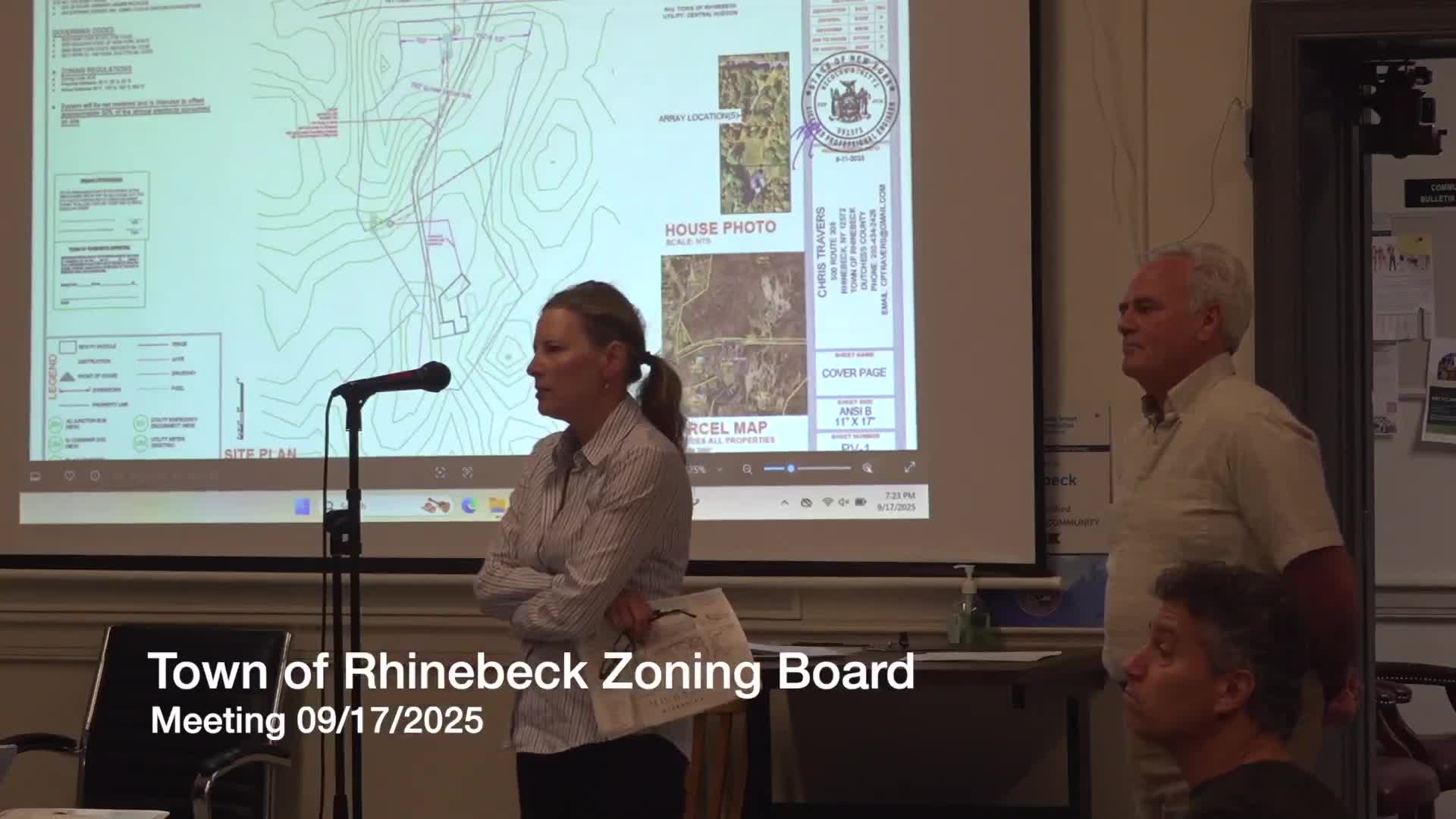Applicant seeks 20-foot variance for ground‑mounted solar at historic property; board set site visit and Oct. 15 follow‑up
October 05, 2025 | Rhinebeck, Dutchess County, New York
This article was created by AI summarizing key points discussed. AI makes mistakes, so for full details and context, please refer to the video of the full meeting. Please report any errors so we can fix them. Report an error »

Chris Reitman, representing Ensemble and Battery Solutions, presented a ground‑mounted solar proposal for a historic property on Route 308, explaining the applicant is seeking an 80‑foot setback variance from the town’s 100‑foot requirement because roof‑mounted panels are not feasible due to historic roof materials and shading.
Why it matters: The application raises typical tradeoffs in historic districts: siting panels so they are hidden from principal views while achieving adequate solar access. The applicant said the chosen location is “nestled in amongst some trees” and not visible from the road even in winter; the board requested a site visit and additional documentation.
Key details from the presentation
- Variance requested: 80 feet instead of 100 feet (applicant described the array as “a little shy” of the 80‑foot mark but seeking relief).
- Visibility: Reitman said he conducted wintertime photos and that the proposed location is tucked behind a natural berm and trees so it is not visible from Route 308 or the driveway approaches.
- Property constraints: The house is historic, the roof is not suitable for solar panels and tree cover limits other locations; the chosen ground location required limited tree clearing.
- Schedule pressure: Reitman said federal tax-credit deadlines (investment tax credit) are a factor and that installation work typically takes three days, weather permitting.
Procedure and next steps
- The ZBA opened the public hearing and received the presentation. The board scheduled a site visit for Oct. 11 and continued the public hearing to Oct. 15, 2025, to allow Planning Board action and to consider an archaeological study that the applicant said would be delivered by Sept. 22.
Quote (from the record)
- Chris Reitman (applicant representative): “So it’s kind of up in here…this is heading east, I believe…so the variance is we’d like to have 80 feet as opposed to the 100 that the town requires.”
Ending
The ZBA did not vote on the application Sept. 17; it will review the site with members present on Oct. 11 and consider a resolution Oct. 15. The applicant is preparing an archaeological report and asked for flexibility to meet tax-credit schedules.
Why it matters: The application raises typical tradeoffs in historic districts: siting panels so they are hidden from principal views while achieving adequate solar access. The applicant said the chosen location is “nestled in amongst some trees” and not visible from the road even in winter; the board requested a site visit and additional documentation.
Key details from the presentation
- Variance requested: 80 feet instead of 100 feet (applicant described the array as “a little shy” of the 80‑foot mark but seeking relief).
- Visibility: Reitman said he conducted wintertime photos and that the proposed location is tucked behind a natural berm and trees so it is not visible from Route 308 or the driveway approaches.
- Property constraints: The house is historic, the roof is not suitable for solar panels and tree cover limits other locations; the chosen ground location required limited tree clearing.
- Schedule pressure: Reitman said federal tax-credit deadlines (investment tax credit) are a factor and that installation work typically takes three days, weather permitting.
Procedure and next steps
- The ZBA opened the public hearing and received the presentation. The board scheduled a site visit for Oct. 11 and continued the public hearing to Oct. 15, 2025, to allow Planning Board action and to consider an archaeological study that the applicant said would be delivered by Sept. 22.
Quote (from the record)
- Chris Reitman (applicant representative): “So it’s kind of up in here…this is heading east, I believe…so the variance is we’d like to have 80 feet as opposed to the 100 that the town requires.”
Ending
The ZBA did not vote on the application Sept. 17; it will review the site with members present on Oct. 11 and consider a resolution Oct. 15. The applicant is preparing an archaeological report and asked for flexibility to meet tax-credit schedules.
View full meeting
This article is based on a recent meeting—watch the full video and explore the complete transcript for deeper insights into the discussion.
View full meeting
